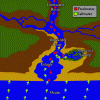I have been doing lots of research on brackish setups, as I am planning to do one myself. I thought I would share what I found with mfk. This should answer most questions for those new to brackish. Here we go.
What is Brackish?- Where the ocean meets outward flowing rivers, saltwater and freshwater mix. This half salt/half fresh mix is called brackish water.
Why Brackish?- Brackish waters are home to an amazing diverse and unique group of animals, many can be kept in the home aquarium. Also If you want to do a saltwater tank in the future, brackish is a great start and to practice. Also not many people do brackish, it is very unique in aquariums. Also, brackish tanks are easy to maintain since the fish from brackish waters are designed to withstand frequent salinity and water parameter changes unlike both fresh and saltwater fish.
Substrate- Brackish water areas always are covered in a sandy, silty, or muddy material. Sand is probably the best option, as it is easiest to maintain. You could use marine aragonite, "Minerial Mud", or sand.
Heater/Filter- Be sure that your heater and filter are rated for both fresh and salt water. Other than that everything is the same as for fresh or salt.
Protine skimmer?- Not necessary, in fact it may remove some important trace elements of the brackish water. Save them for full salt.
Plants?- There are almost no plants that can survive in brackish water. Neither freshwater plants or saltwater plants/corals will do well. Stick with plastic plants. The only acception is the mangrove, as you will find out later in this article.
Marine Salt. I like Instant Ocean but any brand of ocean salt will be fine. No freshwater salt! that is not the salt that brackish animals need in the wild. It is half ocean water and half freshwater!
How much salt?- your salt level should be around 1.005. but it also depends on your type and stock. Yes you need a meter to test this. The instructions on the salt you buy should tell you how much you need per gallon for a brackish setup.
Types of Brackish- I will put thease on seperate posts. Read the setups then look at the pic below to see where on the river they are.
(Please don't post any comments until I am done )
)

What is Brackish?- Where the ocean meets outward flowing rivers, saltwater and freshwater mix. This half salt/half fresh mix is called brackish water.
Why Brackish?- Brackish waters are home to an amazing diverse and unique group of animals, many can be kept in the home aquarium. Also If you want to do a saltwater tank in the future, brackish is a great start and to practice. Also not many people do brackish, it is very unique in aquariums. Also, brackish tanks are easy to maintain since the fish from brackish waters are designed to withstand frequent salinity and water parameter changes unlike both fresh and saltwater fish.
Substrate- Brackish water areas always are covered in a sandy, silty, or muddy material. Sand is probably the best option, as it is easiest to maintain. You could use marine aragonite, "Minerial Mud", or sand.
Heater/Filter- Be sure that your heater and filter are rated for both fresh and salt water. Other than that everything is the same as for fresh or salt.
Protine skimmer?- Not necessary, in fact it may remove some important trace elements of the brackish water. Save them for full salt.
Plants?- There are almost no plants that can survive in brackish water. Neither freshwater plants or saltwater plants/corals will do well. Stick with plastic plants. The only acception is the mangrove, as you will find out later in this article.
Marine Salt. I like Instant Ocean but any brand of ocean salt will be fine. No freshwater salt! that is not the salt that brackish animals need in the wild. It is half ocean water and half freshwater!
How much salt?- your salt level should be around 1.005. but it also depends on your type and stock. Yes you need a meter to test this. The instructions on the salt you buy should tell you how much you need per gallon for a brackish setup.
Types of Brackish- I will put thease on seperate posts. Read the setups then look at the pic below to see where on the river they are.
(Please don't post any comments until I am done







